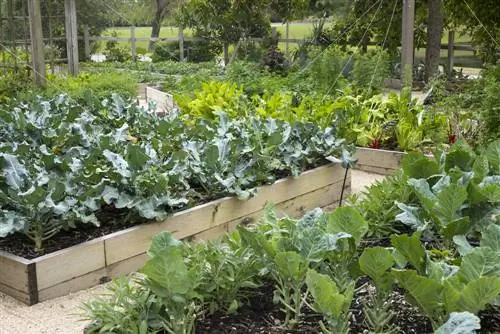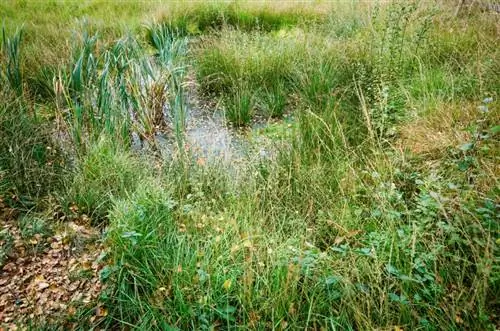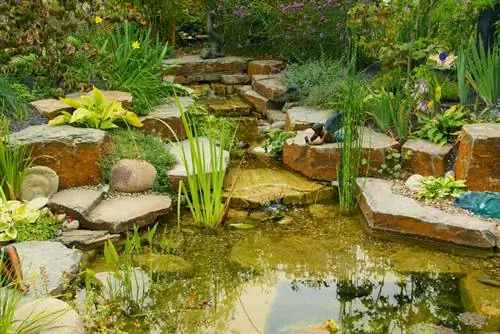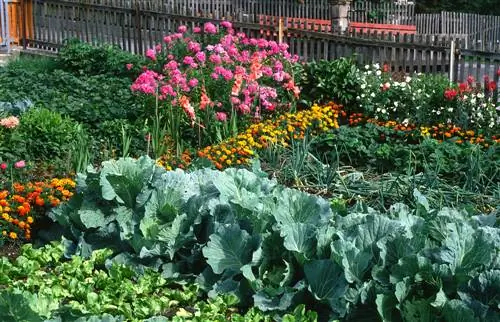- Author admin [email protected].
- Public 2023-12-16 16:46.
- Last modified 2025-06-01 06:02.
As a symbol of floral life and fertility, the classic cottage garden has lost none of its fascination. Here flowers, fruit and vegetable plants thrive side by side. What at first glance appears to be a motley collection is actually based on a well thought-out concept. These instructions get to the heart of how to create an authentic cottage garden.
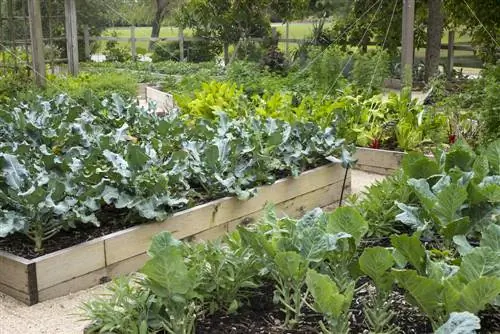
How do I create a cottage garden?
Creating a cottage garden means harmoniously combining vegetables, fruit and ornamental plants. Traditional elements are four beds with borders, a cross, a central element and natural materials for bed borders and enclosures. The mixed culture promotes growth and prevents diseases.
Floor plan follows ancient traditions - overview of the basic elements
The magnificent monastery gardens of the Middle Ages served farmers as a model for their own garden design. The surviving St. Gallen monastery plan from 826 shows a concept with four supporting pillars: fruit, herb and vegetable gardens are arranged around a large cloister. Since the rural population had less fertile land than the well-heeled monks, the elements of the monastery gardens came together in the farm garden to form a single unit. The resulting floor plan with the following components is still valid today:
- 4 square or rectangular beds with edging form the basic structure
- 3 beds are reserved for vegetable plants, 1 bed accommodates local crops and herbs
- A crossroads serves as access to each bed
- The centerpiece is a fruit tree, fountain, rose rondel or pavilion
A surrounding path and a fence mark the demarcation from the outside. A distance of 60 to 100 cm between the path and the fence creates space for additional planting areas where berry bushes traditionally thrive. If space allows, decorative elements made from natural materials give the farm garden a true-to-original appearance. A bench made of natural stone or a fountain made of fired bricks as well as path surfaces made of bark mulch or gravel fit perfectly into the historical concept.
Ideas for borders and fencing
In the authentic farm garden, mixed culture reigns in a particularly pronounced form. The bed borders and the fencing of the property ensure order in the colorful appearance. Natural materials and robust perennials fulfill this task brilliantly. Browse the following ideas to create your cottage garden true to the original:
Bed borders
- Bergilex (Ilex Crenata)
- Dwarf ligustrum (Ligustrum vulgare)
- Lavender (Lavender officinalis)
- Thyme (thymus)
- Tagetes (Tagetes)
- Blue cushion (Aubrieta)
- Alternative: small woven fence, upright wooden posts or low dry stone walls
Enclosure
- Picket fence made of untreated chestnut wood
- Wave willow fence
- Hunter's fence made of unglazed spruce or pine wood
- Wooden fence with fence peepers, such as hollyhocks, clematis or dahlias
- Evergreen or deciduous hedge shrubs
The formal, geometric floor plan and the depicted enclosures create an unobtrusive order in the lively appearance of the cottage garden. This opens up a lot of scope for designing the planting plan within the individual beds, as the following section explains in more detail.
Planting plan for the decorative cottage garden - recommended plants
Properly laid out, a cottage garden benefits from the advantages of mixed culture with crop rotation. Specifically, ornamental and useful plants are brought together here, promoting each other's growth and protecting each other from diseases. By gathering plants with similar nutrient requirements in each bed and moving to the next bed every year, the garden soil remains he althy. The following planting plan illustrates how the proven concept works:
Bed 1 (heavy feeder)
For the first year in your cottage garden, plan vegetable plants with high nutrient requirements for bed 1. This includes all types of cabbage, such as cauliflower (Brassica oleracea var. botrytis), Brussels sprouts (Brassica oleracea var. gemmifera) or broccoli (Brassica oleracea). Cucumbers (Cucumis sativus), potatoes (Solanum tuberosum) and tomatoes (Solanum lycopersicum) also belong to this category. Foxgloves (Digitalis), sunflowers (Helianthus) and delphiniums (Consolida ajacis) provide beautiful flowers here.
Tip
The art of planting in the cottage garden is to combine mixed culture and crop rotation correctly from a cultural perspective. Potatoes and tomatoes are among the heavy eaters. However, mixed culture prohibits a neighborhood in the bed due to the high risk of infection from late blight.
Beet 2 (middle feeder)
A wide range of medium-consuming vegetable plants brings variety to the home menu. From crisp salads such as lettuce (Lactuca sativa) and endive (Cichorium endivia) to juicy beetroot (Beta vulgaris) to extremely he althy spinach (Spinacia oleracea) and hearty carrots (Daucus), you are spoiled for choice. Colorful flowers like to be added, such as peonies (Paeonia), purple bells (Heuchera) and columbines (Aquilegia vularis).
Beet 3 (weak feeder)
In the third bed, plant low-feeding vegetable plants, which will move into bed 1 of the heavy feeders in the second year, because they make do with what nutrients are left over from potatoes and cabbage. Goose cress (Arabis caucasica) and pansies (Viola) harmonize wonderfully with peas (Pisum sativum), lentils (Lens culinaris) or purslane (Portulaca oleracea). Onion flowers, such as snowdrops (Galanthus) or crocuses (Crocus), ensure a blooming start to the gardening year. At the end of the gardening year, autumn crocus (Colchicum autumnale) and saffron (Crocus sativus) shine in their blossoms.
Beet 4 (location loy alty)
Beet 4 is predestined for long-lasting, local vegetable plants, such as rhubarb (Rheum rhabarbarum) or strawberries (Fragaria). Natural herbal plants of all kinds are also welcome here, such as sage (Salvia), wild garlic (Allium ursinum) and parsley (Petroselinum crispum). Symbolic cottage garden flowers decorate the bed with their pretty blossoms, such as Madonna lilies (Lilium candidum) or Mary flowers, known as daisies (Bellis perennis).
Tip
Can't decide between an English garden and a cottage garden? Then simply combine both garden concepts with each other, as is celebrated in the legendary Sissinghurst Castle. In addition to the world-famous White Garden and Rose Garden, another garden room is dedicated to the historical concept of the cottage garden.

